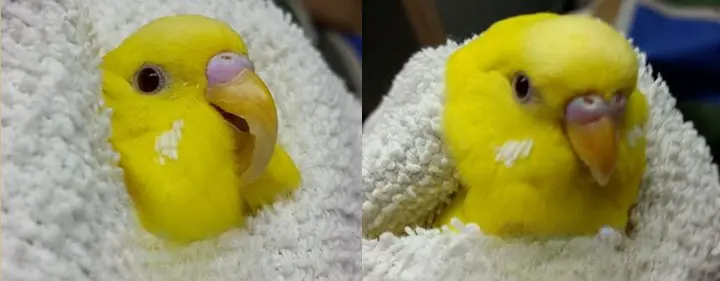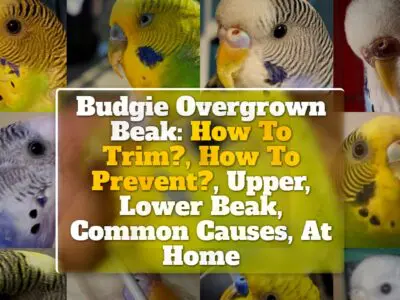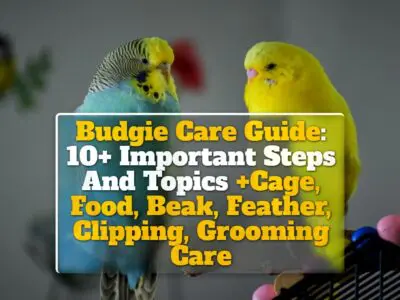Yes, you can trim your budgie’s beak, but it’s a delicate process that must be approached with caution.
If the beak becomes overgrown due to health issues or lack of natural wearing down, trimming may be necessary.
However, always consult a vet first.
Budgie owners, bird lovers, and caregivers, this one’s for you.
With a rich history of owning budgies and a passion for avian care, I noticed a recurring question: “Can I trim my budgie’s beak?” By blending my experiences and learnings from assorted resources, I have put together this comprehensive guide that outlines the process of beak trimming at home, while highlighting the importance of seeking professional help.
Please bear in mind, although this guide provides detailed steps, beak trimming should ideally be left to professionals, like avian vets.
The beak is an intricate and sensitive part of a bird, and improper trimming can result in injuries or health issues.
Hence, these steps are presented as a guiding path but should not replace the advice or intervention of a professional.
Can You Trim a Budgie’s Beak?
Indeed, you can trim a budgie’s beak, but it’s a procedure that demands caution, precision, and a gentle touch.
Budgies, like many other bird species, possess beaks that grow continuously throughout their lives.
Regular wear from eating and playing naturally grinds down the beak, maintaining an appropriate length.
However, in some instances, a budgie’s beak may overgrow due to health issues, improper diet, or lack of natural grinding opportunities.
This overgrowth can interfere with the bird’s ability to eat and may even cause discomfort or pain.
In such situations, beak trimming may become necessary.
However, a budgie’s beak isn’t just a simple structure.
It’s rich in nerve endings and contains a blood supply, known as the ‘quick.’ Cutting into this area by accident can cause immense pain and potential health complications for the bird.

Therefore, it’s strongly advised to seek professional assistance when beak trimming becomes necessary.
While you can undertake this task at home with the appropriate knowledge, tools, and caution, it’s generally safer and less stressful for the bird if a trained avian vet handles the process.
Risks Associated with Trimming a Budgie’s Beak at Home
Trimming a budgie’s beak at home comes with its share of risks and potential complications.
The beak is a complex, highly vascularized structure that serves as more than just a tool for feeding.
It plays a significant role in a bird’s communication, mobility, and overall wellbeing.
Incorrect or inexperienced handling can inadvertently harm your budgie, leading to stress, injury, and sometimes serious health problems.
One of the most common risks associated with at-home beak trimming is the potential to cut into the ‘quick’—the part of the beak that houses blood vessels and nerves.
This can result in severe pain and bleeding, causing immediate distress for the bird and potentially leading to infection or other complications if not managed correctly.
In some severe cases, excessive blood loss can be life-threatening.
Another risk involves improperly shaping or shortening the beak.
Budgies use their beaks for various activities, including climbing, playing, and feeding.
A beak that’s improperly shaped or excessively shortened can hinder these activities, leading to malnutrition or physical injuries.
It may also cause the bird to experience discomfort or pain, which in turn can lead to behavioral changes or stress-related health issues.
The stress of the procedure itself should not be underestimated.
Birds, budgies included, are sensitive creatures, and the physical restraint and unfamiliar sensations associated with beak trimming can cause a high level of stress, potentially leading to negative health impacts.
Professional Assistance for Beak Trimming
Given the risks associated with at-home beak trimming, it’s strongly recommended to seek professional assistance when your budgie’s beak needs attention.
Avian veterinarians or experienced bird groomers possess the specialized training and tools necessary to safely and effectively perform a beak trim.
They understand the structure of the beak, know where and how much to trim, and can expertly manage any complications that might arise.
Professional beak trims not only reduce the risks associated with the procedure but can also provide added benefits.
An avian vet can use the opportunity to perform a general health check, identify and address any underlying health issues that might be contributing to beak overgrowth, and offer advice on diet or care adjustments to promote natural beak health.
When Should a Budgie’s Beak Be Trimmed?
The ideal time to trim a budgie’s beak is when the beak’s length or shape begins to interfere with the bird’s normal activities, such as eating or playing.
Some signs that your budgie’s beak may need trimming include difficulty picking up or eating food, overgrown or elongated beak, unusual flaking or color changes, or if the bird appears to be in discomfort.
However, remember that occasional slight overgrowth is often rectified by the bird itself through natural grinding behaviors, such as gnawing on cuttlebones or wooden toys.
A beak that’s slightly longer or uniquely shaped doesn’t necessarily warrant immediate trimming.
It’s crucial to establish that beak trimming isn’t a regular grooming task like nail clipping.
It’s a procedure that’s only performed when necessary and typically under professional supervision.
Regularly observe your budgie and its habits, and if you suspect a beak-related issue, consult an avian vet to determine if beak trimming is necessary.
Steps to Trim a Budgie’s Beak at Home
Despite the risks and recommended professional intervention, there may be instances where you find yourself needing to trim your budgie’s beak at home.
In such cases, it’s crucial to take every step possible to ensure the safety and wellbeing of your bird.
The following are the step-by-step instructions for trimming a budgie’s beak at home, ensuring you’re as informed as possible when handling this delicate process.
Step 1: Preparation
Preparation is vital when dealing with a procedure as delicate as beak trimming.
Gather all your necessary supplies, including a bird beak trimmer or a small pair of bird nail scissors, a towel, styptic powder (to halt any potential bleeding), and a torch or a bright light source to clearly illuminate the beak structure.
Sanitizing your hands before the procedure is crucial to prevent potential infection.
Step 2: Calming Your Budgie
Next, it’s important to create a calm environment for your budgie.
You can achieve this by gently wrapping your bird in a towel, leaving only its head exposed.
This technique, often called “toweling,” helps calm the bird and prevent it from flapping its wings or attempting to escape during the procedure.
Step 3: Examination
Examine your budgie’s beak thoroughly.
The objective here is to carefully distinguish between the thin, translucent part of the beak, which is safe to trim, and the darker, denser part closer to the base.
You should avoid touching this darker part, as it contains sensitive nerves and blood vessels that can cause pain or bleeding if cut.
Step 4: Trimming
Holding the beak trimmer or nail scissors in your dominant hand and the bird in your other hand, proceed to carefully trim the overgrown part of the beak.
It’s important to only trim a small amount at a time to avoid cutting into the quick, which can cause bleeding and inflict pain on your budgie.
Step 5: Dealing with Bleeding
In the event of accidental bleeding, apply the styptic powder immediately to the affected area.
The powder will help coagulate the blood and stop the bleeding.
If bleeding continues for more than a few minutes, it’s imperative to seek veterinary attention promptly.
Step 6: Observation and Care
After trimming, close observation of your budgie’s behavior is essential.
Ensure that your bird can eat and drink properly.
Look out for any signs of distress—if your bird appears uncomfortable or unable to carry out normal activities, contact your vet immediately.
Step 7: Regular Maintenance
Providing regular maintenance and natural methods for your budgie to manage its beak health is a crucial preventive measure.
Offering your budgie cuttlebones, wooden toys, and a variety of hard, crunchy foods can help naturally keep its beak trim and prevent overgrowth in the future.
Aftercare and Beak Health Maintenance
To ensure the best aftercare and beak health maintenance for your budgie post-trimming, here are the steps you should follow:
- Observe Your Budgie: Monitor your budgie closely for any behavioral changes or difficulties in eating.
- Manage Discomfort: If you notice your budgie is in discomfort, consult your vet immediately. They may prescribe pain relief medication to help your budgie cope with the discomfort.
- Maintain Hygiene: Clean the beak area gently with a soft, wet cloth to remove any debris or blood traces.
- Provide a Nutritious Diet: Continue offering a balanced diet. Foods rich in calcium like cuttlebone can help strengthen the beak.
- Regular Health Check-ups: Schedule regular health check-ups with your vet to monitor the beak growth and overall health of your budgie.
- Prevent Beak Overgrowth: To prevent beak overgrowth, provide plenty of toys or wooden perches that your budgie can chew on. This natural activity helps wear down the beak, reducing the need for future trimmings.
- Monitor Beak Appearance: Regularly check for any changes in the color, shape, or texture of your budgie’s beak.
- Address Abnormalities Promptly: If you notice any abnormalities, contact your vet without delay. Early detection can lead to prompt treatment and prevent further complications.
Faqs
Can I Trim My Budgie’s Beak Without Any Professional Assistance?
While it’s technically possible to trim your budgie’s beak without professional assistance, it’s not recommended.
The beak is an extremely sensitive part of a budgie and improper trimming can lead to serious injury or infection.
A trained avian vet should ideally carry out this procedure.
What Equipment Do I Need to Trim My Budgie’s Beak at Home?
To trim your budgie’s beak at home, you’ll need specific tools such as a bird beak trimmer or small bird nail scissors, a towel, styptic powder for any accidental bleeding, and a bright light source to see the beak structure clearly.
Hygiene is paramount, so remember to wash your hands before the procedure.
Are There Any Risks Involved in Trimming My Budgie’s Beak at Home?
Yes, there are risks involved in trimming your budgie’s beak at home.
The beak is a very sensitive part, and improper trimming can cause pain, bleeding, or even infection. The bird might also experience stress during the procedure.
Can I Prevent My Budgie’s Beak from Becoming Overgrown?
Yes, you can prevent your budgie’s beak from becoming overgrown by providing beak-friendly items in the bird’s environment.
Cuttlebones, mineral blocks, and chewable toys help naturally wear down the beak.
Also, providing a varied diet with a mix of hard and soft foods aids in naturally keeping the beak trim.
What Should I Do After Trimming My Budgie’s Beak at Home?
After trimming your budgie’s beak at home, observe your bird closely for any signs of discomfort or distress.
Keep a close eye on its eating and drinking habits.
Regularly inspect the trimmed beak for any signs of infection.
How Can I Ensure My Budgie Remains Calm During Beak Trimming at Home?
Ensuring your budgie remains calm during a beak trimming procedure at home requires careful handling and a quiet environment.
Using a soft towel to gently wrap your budgie can provide a sense of security.
Also, talking soothingly to your budgie or playing soft music can help keep your bird calm.
Can I Use Human Nail Clippers to Trim My Budgie’s Beak?
While you may be tempted to use human nail clippers, they are not recommended for trimming a budgie’s beak.
The beak’s structure is different from human nails, and nail clippers can cause uneven trimming or even fractures.
Use designated bird beak trimmers or small bird nail scissors for a safer, more precise cut.
What Are the Signs that My Budgie’s Beak Needs Trimming?
Signs that your budgie’s beak needs trimming include an excessively long or misshapen beak, difficulty eating, or the beak curving into the chest or tongue.
Is There a Specific Technique to Trim a Budgie’s Beak?
Trimming a budgie’s beak involves careful examination, precise cutting, and quick response to any accidental bleeding.
The beak should be cut bit by bit, avoiding the blood vessels visible in the beak’s translucent portion.
If bleeding occurs, it should be promptly addressed using styptic powder.


![New Budgie’s First Days at Home & Behavior [What to Do?]](https://www.petiska.com/wp-content/uploads/2022/05/new-budgies-first-days-at-home-behavior-what-to-do-1653309166-400x300.jpg)
